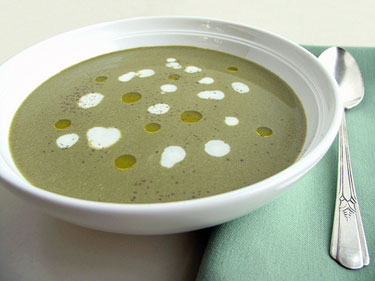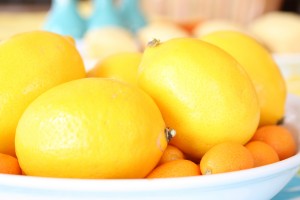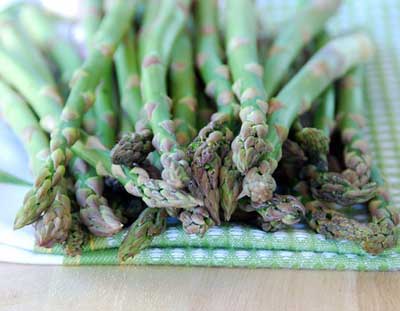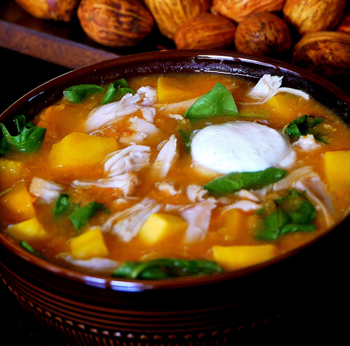 I love unique spring vegetables—it's the reason why I write about such things like ramps and fiddleheads so much. For me there's nothing better than combining my favorites in one recipe to celebrate the spring season. Ramps on their own would make a particularly good soup. But looking for a contrasting flavor to pair it with, I thought of sorrel. With its tart and citrusy flavor, the leafy green is a perfect foil for pungent and oniony ramps.
I love unique spring vegetables—it's the reason why I write about such things like ramps and fiddleheads so much. For me there's nothing better than combining my favorites in one recipe to celebrate the spring season. Ramps on their own would make a particularly good soup. But looking for a contrasting flavor to pair it with, I thought of sorrel. With its tart and citrusy flavor, the leafy green is a perfect foil for pungent and oniony ramps.
This season the weather hasn't really brought us much of a warm spring just yet. Instead we've gotten endless chilly days, but luckily those days present us with the perfect opportunity to eat spring soups. Rich flavored, creamy soups are the best way to soothe and satisfy when you need uplift on a cold day. And say if suddenly the weather turns for the better, these types of soups are also great chilled on a warm day.
Spring
Spring
Radishes with Butter and Salt
 This really isn't a recipe—it doesn't even involve cooking or assembly. It's just a few simple ingredients brought together in a perfect way: radishes, butter, and salt. Most people don't give radishes a second thought mainly because they don't eat them. As I've shown in recipes before and will show this week, radishes can be made into many different dishes with ones that are even cooked. But the absolute best way to eat them is with just a little salt and butter.
This really isn't a recipe—it doesn't even involve cooking or assembly. It's just a few simple ingredients brought together in a perfect way: radishes, butter, and salt. Most people don't give radishes a second thought mainly because they don't eat them. As I've shown in recipes before and will show this week, radishes can be made into many different dishes with ones that are even cooked. But the absolute best way to eat them is with just a little salt and butter.
Radishes are a very humble vegetable, so you would never expect to eat them anywhere but home, let alone find them served at a high-end restaurant. But a few years ago at ABC Kitchen I was served radishes with salt, bread, and butter.
I couldn't believe my eyes because it was such a simple presentation but a very effective one that truly represented the restaurant's "green" objective very clearly—it was all about the fresh produce. Besides all the wondeful dishes I enjoyed that evening, the radishes really stood out in my mind and memory—it's why I'm writing about them now.
Meyer Lemon Tea Cake
 Spying bright yellow Meyer lemons in the refrigerated produce case at my local natural food co-op never fails to give me a lift. This occurrence usually takes place in March, my least favorite month of the year in northern Minnesota with its dull gray skies, dirty slush, and sometimes, snowstorms that, by this time, no one wants to experience.
Spying bright yellow Meyer lemons in the refrigerated produce case at my local natural food co-op never fails to give me a lift. This occurrence usually takes place in March, my least favorite month of the year in northern Minnesota with its dull gray skies, dirty slush, and sometimes, snowstorms that, by this time, no one wants to experience.
I grabbed several Meyer lemons last week, brought them home and arranged them in a shallow white bowl with the kumquats that also came home with me.
After enjoying their burst of brightness in my kitchen for a couple of days, I knew it was time to use them up. I was ready to make some little tea cakes, tiny loaves infused with the juice of Meyer lemons.
How to Select, Store, and Cook with Asparagus
 It's May 12th, and asparagus season is nearly over here in Southern California. While the majority of the country enjoys asparagus from April to June, our season usually stretches from late February to early May.
It's May 12th, and asparagus season is nearly over here in Southern California. While the majority of the country enjoys asparagus from April to June, our season usually stretches from late February to early May.
I'm not sad though -- this season's asparagus has been superb. The smooth, svelte green stalks with delicate purple tinged tips have had a mildly earthy flavor and deliciously tender texture. Since I've been buying two bunches of asparagus nearly every week for the last two months, I've learned a few things, So here are some tips on how to select, store, and cook with asparagus.
How to select asparagus: What's better, thin or thick stalks of asparagus?
Both. No, that's not a typo. Every spring there is an endless debate over which is better, thin or thick stalks. Most people swear thick asparagus stalks are tough. I disagree. I have eaten many tender and flavorful thick stalks of asparagus. What' really important is the quality of the stalk: look for straight, firm green stalks with light purple tinged tips. Look at the bottoms of the stalks. If they're white, dry, and woody, then they're probably old. Also avoid shriveled, overly dry, or pitted stalks.
Asparagus, Bacon & Cheese Quiche
 One of the first signs that spring has arrived is the availability of bright green vegetables, like asparagus. There is something special about an asparagus spear emerging from the ground. Right now asparagus is available at the Union square Greenmarket. In the supermarket it's available all-year round, but the best time to get pencil-thin asparagus is during springtime. It's at its most tender and succulent. Steamed for a few minutes, roasted, or grilled, asparagus is a delightful vegetable prepared in any which way. Its color becomes vivid green after cooking and for me that represents the essence of spring.
One of the first signs that spring has arrived is the availability of bright green vegetables, like asparagus. There is something special about an asparagus spear emerging from the ground. Right now asparagus is available at the Union square Greenmarket. In the supermarket it's available all-year round, but the best time to get pencil-thin asparagus is during springtime. It's at its most tender and succulent. Steamed for a few minutes, roasted, or grilled, asparagus is a delightful vegetable prepared in any which way. Its color becomes vivid green after cooking and for me that represents the essence of spring.
I enjoy eating asparagus in many forms, but I like it most in quiche, one of the favorite brunch foods here in the States. Though the French even eat it for lunch or dinner. Quiche was originally meant just for breakfast in the French province of Lorraine, from where it originated. Surprisingly the tradition of quiche-making comes from a time when Lorraine belonged to Germany. The dish used to be called kuchen, which is German for cake, and instead of a pie crust, it was made with bread dough—basically a pizza. Once the region changed rule, the German name was eventually transliterated into French and the recipe changed too. The most well-known recipe is Quiche Lorraine, filled with just bacon.
More Articles ...
Welcome to the new One for the Table ...
Our Home Page will be different each time you arrive.
We're sure you'll find something to pique your interest...

